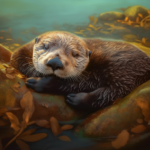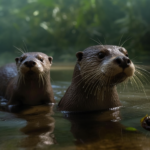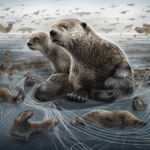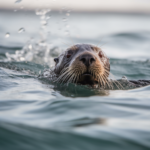River Otters in NC
River otters are fascinating creatures that inhabit the waterways of North Carolina (NC). These playful and intelligent mammals are known for their sleek bodies, webbed feet, and long, muscular tails. They are highly adapted to their aquatic lifestyle, with dense fur that keeps them warm in the water and powerful jaws that allow them to catch and consume their prey. River otters play a crucial role in the ecosystem, serving as indicators of water quality and helping to maintain a balanced population of fish and other aquatic species. In this article, we will explore the life of river otters in NC, their habitat, behavior, and the conservation efforts being made to protect these charismatic animals. So, let’s dive in and discover the world of river otters in NC!
Key Takeaways
- River otters are native to North Carolina and play a vital role in maintaining the health of aquatic ecosystems.
- They are highly adaptable and can be found in a variety of habitats, including rivers, lakes, and marshes.
- River otters are excellent swimmers and have a streamlined body and webbed feet that enable them to navigate through water with ease.
- They are carnivorous and feed on a diet consisting mainly of fish, amphibians, and crustaceans.
- Conservation efforts are essential to protect river otters and their habitats, ensuring their continued presence in North Carolina’s ecosystems.
The Presence of River Otters in North Carolina
A. River Otters in Western NC
North Carolina is home to a diverse array of wildlife, including the charismatic river otter. These playful and intelligent creatures can be found throughout the state, including in the western region. The mountainous terrain and abundant water sources in western NC provide an ideal habitat for river otters.
River otters are well-adapted to an aquatic lifestyle, with their streamlined bodies, webbed feet, and thick fur that keeps them warm in the water. They are excellent swimmers and can gracefully navigate through rivers, streams, and lakes. In western NC, otters can be spotted in various water bodies, such as the French Broad River, Nantahala River, and Lake Fontana.
B. Wild Otters in NC: A Natural Presence
River otters have been a natural presence in North Carolina for centuries. They are native to the state and have played an important role in the local ecosystem. These aquatic mammals are known as “keystone species” because their presence has a significant impact on the overall health and balance of the ecosystem.
River otters are opportunistic feeders and consume a variety of prey, including fish, crayfish, frogs, and small mammals. By regulating the populations of these prey species, otters help maintain the ecological balance of North Carolina’s rivers and wetlands. Additionally, their burrowing activities create shelter for other wildlife and help aerate the soil, benefiting plant growth.
C. Are There Sea Otters in NC?
While river otters are found in North Carolina, sea otters are not native to the state. Sea otters primarily inhabit coastal areas of the Pacific Ocean, from Alaska to California. These marine mammals have a distinct appearance, with their dense fur and webbed feet.
Sea otters are known for their remarkable ability to use tools, such as rocks, to crack open shellfish. They primarily feed on marine invertebrates, including sea urchins, clams, and crabs. Unfortunately, due to historical hunting and habitat loss, sea otter populations have declined significantly, and they are currently listed as a threatened species.
In North Carolina, if you come across an otter near the coast, it is likely a river otter rather than a sea otter. River otters may occasionally venture into brackish or saltwater habitats, but their primary range is in freshwater environments.
In conclusion, river otters are a fascinating and important part of North Carolina’s wildlife. Their presence in both western and other parts of the state contributes to the overall biodiversity and ecological balance. By understanding and appreciating these remarkable creatures, we can work towards their conservation and the preservation of North Carolina’s natural heritage.
River Otters Beyond North Carolina: A Comparative Study
A. Are There River Otters in Oklahoma?
When it comes to river otters, North Carolina is known for its thriving population and diverse habitats. But what about other states, like Oklahoma? Are river otters found there as well? Let’s explore the presence of these fascinating creatures beyond the borders of North Carolina.
While river otters are not native to Oklahoma, efforts have been made to reintroduce them to the state. In the early 1980s, the Oklahoma Department of Wildlife Conservation initiated a project to bring river otters back to their natural habitat. This endeavor aimed to restore the ecological balance and enhance the biodiversity of Oklahoma’s waterways.
The reintroduction program involved capturing river otters from other states, such as Arkansas and Louisiana, where their populations were more abundant. These otters were then released into suitable habitats in Oklahoma, including rivers, lakes, and wetlands. The project’s success has been evident, with river otters now thriving in various parts of the state.
B. The Absence of Sea Otters in Oklahoma
While river otters have found their way to Oklahoma, it’s important to note that sea otters are not found in the state. Sea otters are a different species altogether, known for their unique adaptations to marine environments. They primarily inhabit coastal areas along the Pacific Ocean, from Alaska to California.
Sea otters have a distinct appearance, with dense fur that helps them stay warm in cold waters. Unlike river otters, they spend most of their lives in the ocean, relying on kelp forests for shelter and food. Sea otters are skilled hunters, using rocks to crack open shells and feed on a diet consisting mainly of shellfish.
Unfortunately, sea otters have faced significant challenges in their conservation efforts. Historically, they were heavily hunted for their fur, leading to a drastic decline in their population. Today, they are protected under the Endangered Species Act, and conservation efforts are ongoing to restore their numbers and protect their habitats.
In conclusion, while river otters have successfully made a comeback in Oklahoma, sea otters are not found in the state. Each species has its own unique characteristics and adaptations, making them well-suited to their respective habitats. By understanding the presence and absence of these otter species in different regions, we can appreciate the diverse ecosystems and conservation efforts required to protect them.
Understanding River Otters: Characteristics and Behavior

A. Are River Otters Dangerous?
River otters are fascinating creatures that inhabit the rivers and waterways of North Carolina. While they may appear cute and playful, it’s natural to wonder if they pose any danger to humans. Let’s explore the behavior of river otters to understand whether they are dangerous or not.
River otters are not typically aggressive towards humans. They are elusive and tend to avoid human contact. However, like any wild animal, they can become defensive if they feel threatened or cornered. It’s important to remember that they are wild animals and should be observed from a safe distance.
In rare cases, river otters may display territorial behavior, especially during mating season or when protecting their young. They may hiss, growl, or even bite if they feel their space is being invaded. It’s crucial to respect their space and not approach them too closely.
B. Unique Traits of River Otters
River otters have several unique traits that make them well-adapted to their aquatic lifestyle. Let’s take a closer look at some of these fascinating characteristics:
-
Sleek and Agile Bodies: River otters have streamlined bodies with dense fur that helps them stay warm in the water. Their long, muscular tails act as rudders, enabling them to navigate through the water with ease.
-
Excellent Swimmers: These aquatic mammals are highly skilled swimmers. They can swim at speeds of up to 7 miles per hour and dive to depths of 60 feet. Their webbed feet and strong hind legs make them efficient underwater hunters.
-
Playful Nature: River otters are known for their playful behavior. They can often be seen sliding down muddy banks or engaging in water games with their otter companions. Play is an essential part of their social interactions and helps strengthen their bonds.
-
Adaptable Diet: River otters are opportunistic eaters and have a diverse diet. They primarily feed on fish, but they also consume crustaceans, amphibians, reptiles, and even small mammals. Their sharp teeth and strong jaws allow them to catch and consume their prey effectively.
-
Social Creatures: River otters are social animals that live in family groups called “rafts.” These rafts typically consist of a female otter, her offspring, and sometimes a male otter. They communicate through a variety of vocalizations, including chirps, whistles, and growls.
-
Territorial Marking: River otters mark their territories by leaving scent markings, known as “spraints.” These spraints are a combination of urine, feces, and glandular secretions. By marking their territories, otters communicate their presence to other otters and establish boundaries.
Understanding the characteristics and behavior of river otters allows us to appreciate these remarkable creatures and coexist with them in their natural habitats. By respecting their space and observing them from a distance, we can ensure the safety of both humans and otters alike.
How to Attract River Otters: A Comprehensive Guide
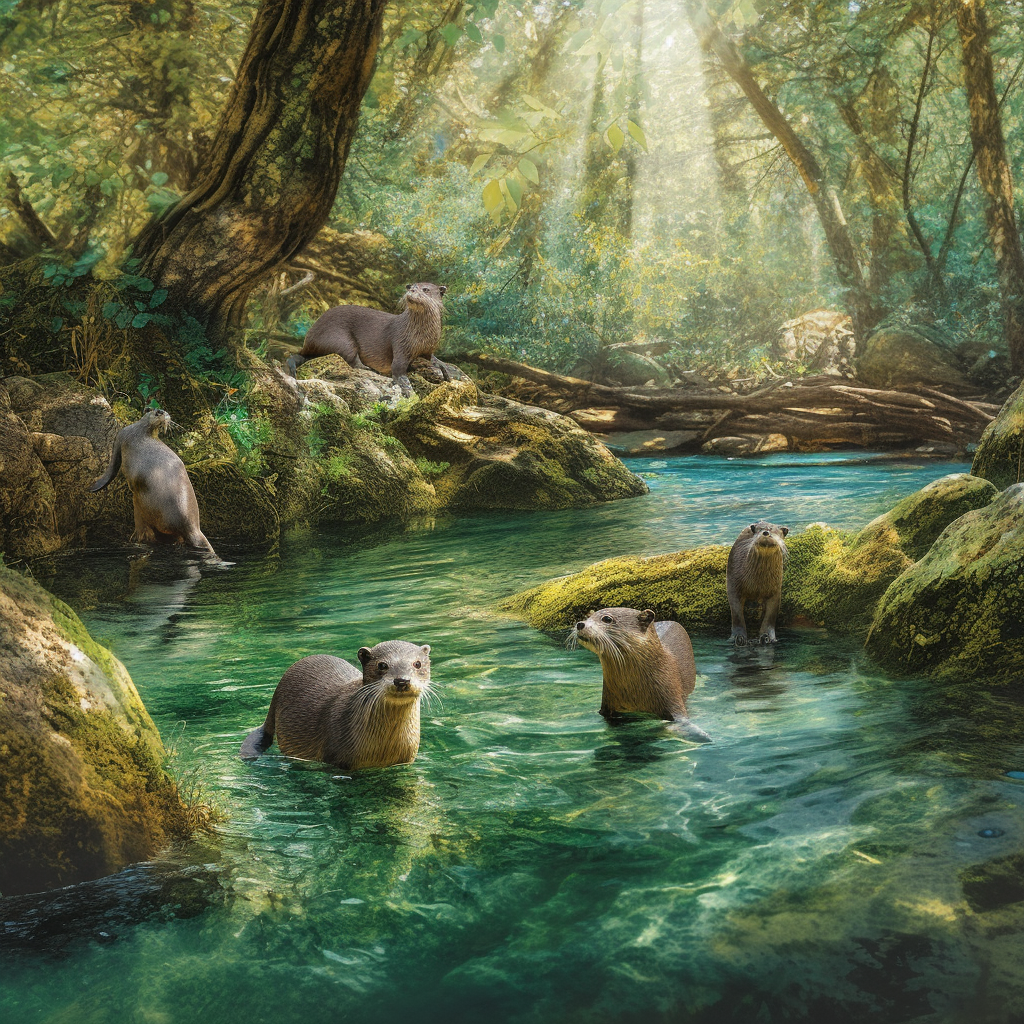
A. Creating a Suitable Habitat
River otters are fascinating creatures that can bring life and excitement to any natural environment. If you’re interested in attracting river otters to your area in North Carolina, creating a suitable habitat is essential. By providing the right conditions, you can encourage these playful and curious mammals to make your property their home. Here are some key steps to consider:
-
Water Source: River otters are semi-aquatic creatures, so having a reliable water source is crucial. If you have a pond, lake, or river nearby, you’re already off to a great start. Ensure that the water is clean and free from pollutants, as otters are sensitive to environmental changes.
-
Vegetation: Otters love areas with abundant vegetation, as it provides cover and a source of food. Planting native aquatic plants along the water’s edge can create an inviting habitat for otters. Species like water lilies, cattails, and duckweed are excellent choices.
-
Shelter: River otters need a safe place to rest and raise their young. Fallen logs, brush piles, and natural cavities along the water’s edge can serve as ideal shelters. If you have the space, consider creating artificial dens using large pipes or wooden boxes.
-
Land and Water Connectivity: Otters are agile both on land and in water. To attract them, ensure that there is a seamless transition between the two environments. Gradual slopes leading into the water and well-maintained trails along the shoreline can encourage otters to explore and inhabit your property.
B. Food Sources that Attract River Otters
To entice river otters to your area, it’s essential to provide a diverse and plentiful food supply. Otters are opportunistic feeders and consume a variety of aquatic prey. Here are some food sources that can attract river otters:
-
Fish: Fish make up a significant portion of a river otter’s diet. Stocking your water source with fish species such as bass, trout, and catfish can help attract otters. Ensure that the fish population is sustainable and that you’re following local regulations regarding stocking.
-
Crustaceans: Crayfish and other crustaceans are also a favorite food of river otters. These small aquatic creatures can be found in freshwater bodies like streams and ponds. Creating a habitat that supports crayfish populations will increase the chances of otters visiting your area.
-
Amphibians: Frogs, toads, and salamanders are another food source for river otters. Providing a suitable environment for these amphibians, such as wetlands or marshy areas, can attract otters looking for a meal.
-
Invertebrates: River otters also feed on a variety of invertebrates, including insects, snails, and clams. Maintaining a healthy and diverse invertebrate population in and around your water source can help support otters’ dietary needs.
Remember, attracting river otters to your property requires patience and dedication. It’s important to respect these animals’ natural behaviors and refrain from interfering with their habitat. By creating a suitable habitat and providing a diverse food supply, you can increase the chances of spotting these charismatic creatures in the wilds of North Carolina.
Adopting a River Otter: An Ethical Perspective
A. The Process of Adopting a River Otter
Adopting a river otter can be a rewarding experience, but it’s important to understand the process involved. River otters are protected wildlife in North Carolina, and their adoption is regulated to ensure their well-being and conservation. If you’re considering adopting a river otter, here’s what you need to know:
-
Research and Preparation: Before embarking on the adoption process, it’s crucial to educate yourself about river otters and their specific needs. Learn about their behavior, habitat requirements, diet, and the responsibilities that come with caring for these aquatic mammals.
-
Contacting the Appropriate Authorities: To legally adopt a river otter in North Carolina, you must reach out to the relevant wildlife conservation agencies or organizations. They will guide you through the process and provide you with the necessary information and paperwork.
-
Meeting the Requirements: River otter adoption typically requires meeting certain criteria. These may include having the appropriate facilities to house and care for the otter, demonstrating knowledge of their needs, and obtaining any required permits or licenses.
-
Facility Inspection: As part of the adoption process, your facility will be inspected to ensure it meets the necessary standards for the otter’s well-being. This inspection helps ensure that the otter will have a suitable environment to thrive in.
-
Training and Education: Adopting a river otter also involves undergoing training and education. This is to ensure that you have the knowledge and skills to provide proper care and meet the otter’s specific needs.
-
Ongoing Support and Monitoring: Once the adoption is approved, you may receive ongoing support and monitoring from the wildlife conservation agency or organization. This helps ensure that the otter is thriving in its new environment and that you have the necessary resources to care for it.
B. Legal and Ethical Considerations
When considering adopting a river otter, it’s essential to take into account the legal and ethical considerations involved. Here are some key points to keep in mind:
-
Legal Compliance: River otters are protected wildlife in North Carolina, and it is crucial to comply with the state’s laws and regulations. By adopting a river otter legally, you contribute to the conservation efforts and help protect these fascinating creatures.
-
Ethical Responsibility: Adopting a river otter comes with ethical responsibilities. It is essential to provide a suitable and enriching environment that mimics their natural habitat. This includes providing ample space for swimming, access to clean water, and opportunities for foraging and play.
-
Conservation Impact: By adopting a river otter, you become part of the larger conservation efforts aimed at preserving North Carolina’s ecosystem. River otters play a vital role in maintaining the balance of aquatic ecosystems and their adoption helps ensure their survival for future generations.
-
Expert Guidance: It is advisable to seek guidance from experts in otter care and conservation. They can provide valuable insights on best practices, diet, enrichment activities, and overall well-being of the otter. This ensures that you are providing the highest standard of care for your adopted otter.
-
Financial Commitment: Adopting a river otter requires a financial commitment. From providing appropriate housing and veterinary care to ensuring a balanced diet, there are costs associated with caring for these animals. It’s important to consider the long-term financial implications before proceeding with the adoption.
Remember, adopting a river otter is a significant responsibility that requires dedication, resources, and a genuine commitment to the well-being of these remarkable creatures. By following the proper process and considering the legal and ethical aspects, you can provide a loving and nurturing home for a river otter while contributing to their conservation efforts in North Carolina.
The Otter Ocean Code: Decoding the Mystery
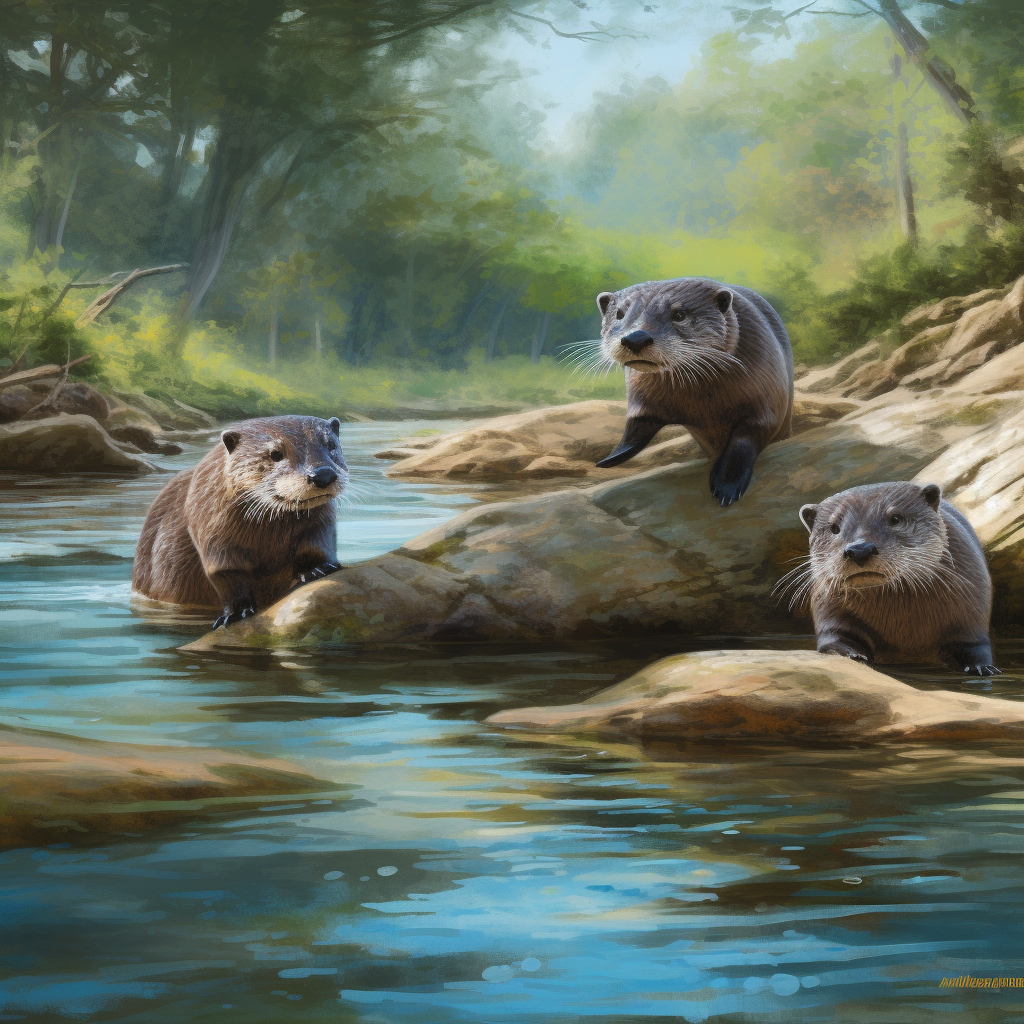
A. Understanding the Otter Ocean Code
River otters are fascinating creatures that inhabit the waterways of North Carolina. These aquatic mammals have captured the curiosity of scientists and wildlife enthusiasts alike, leading to a quest to understand their behavior and ecology. One aspect that researchers have been particularly interested in is what can be referred to as the “Otter Ocean Code.”
The Otter Ocean Code is a term used to describe the unique set of behaviors and adaptations that river otters possess to thrive in their aquatic environment. By deciphering this code, scientists hope to gain further insight into the lives of these charismatic creatures.
One key aspect of the Otter Ocean Code is the river otter’s diet. These carnivorous mammals primarily feed on fish, but they are opportunistic eaters and will also consume crustaceans, amphibians, and even small mammals. Their diet is an essential component of their survival, as it provides the necessary nutrients for their energetic lifestyle.
Another fascinating aspect of the Otter Ocean Code is the river otter’s ability to adapt to different habitats. In North Carolina, river otters can be found in a variety of aquatic environments, including rivers, streams, lakes, and marshes. They have the remarkable ability to navigate through these diverse habitats with ease, thanks to their streamlined bodies, webbed feet, and strong tails, which serve as rudders for steering.
B. Its Relevance to River Otters in NC
Understanding the Otter Ocean Code is particularly relevant to the river otters in North Carolina. The state boasts a rich ecosystem that supports a thriving population of these playful creatures. By studying their behavior and adaptations, scientists can gain valuable insights into the overall health of the ecosystem and the impact of human activities on these animals.
River otters play a crucial role in maintaining the balance of the aquatic ecosystem. As top predators, they help control the population of their prey species, ensuring that the ecosystem remains in equilibrium. Additionally, their presence indicates the overall health of the waterways they inhabit. If river otters are thriving, it is a positive sign that the ecosystem is intact and functioning properly.
Furthermore, the Otter Ocean Code can aid in the conservation efforts of river otters in North Carolina. By understanding their behavior and habitat requirements, conservationists can develop strategies to protect and preserve their habitats. This may involve creating protected areas, implementing pollution control measures, and promoting responsible recreational activities near waterways.
In conclusion, the Otter Ocean Code is a fascinating concept that sheds light on the behavior and adaptations of river otters in North Carolina. By unraveling this code, scientists can gain a deeper understanding of these charismatic creatures and their role in the ecosystem. This knowledge is crucial for their conservation and the preservation of North Carolina’s unique aquatic habitats.
Conclusion
In conclusion, river otters in North Carolina are fascinating creatures that play a vital role in maintaining the health of aquatic ecosystems. These semiaquatic mammals are known for their playful nature, sleek bodies, and excellent swimming abilities. River otters are native to North Carolina and can be found in various habitats, including rivers, lakes, and marshes. They are skilled hunters, feeding on a diet consisting mainly of fish, amphibians, and crustaceans. Despite facing threats such as habitat loss and pollution, efforts are being made to conserve and protect these charismatic animals. The presence of river otters in North Carolina is not only a testament to the state’s diverse wildlife but also a reminder of the importance of preserving and appreciating the natural world around us. By understanding and valuing these remarkable creatures, we can contribute to their conservation and ensure that future generations can continue to enjoy the beauty and wonder of river otters in North Carolina.
Frequently Asked Questions
Q1: Are there river otters in North Carolina?
Yes, river otters are native to North Carolina and can be found in various aquatic habitats across the state, including rivers, streams, and coastal marshes. They are a vital part of the North Carolina ecosystem.
Q2: How can I attract river otters?
Attracting river otters involves creating a suitable habitat for them. This includes ensuring a clean water source, abundant food supply (like fish and crustaceans, which are part of the river otter diet), and safe places for resting and denning. However, it’s important to remember that otters are wild animals and should not be encouraged to become dependent on humans.
Q3: Are there wild otters in North Carolina?
Yes, there are wild otters in North Carolina. They are primarily river otters, which are a species of otter native to North America. They can be spotted in various parts of the state, especially near water bodies.
Q4: Are river otters dangerous?
While river otters are generally not dangerous to humans, they are wild animals and can be aggressive if they feel threatened or cornered. It’s always best to observe them from a distance and never attempt to feed or touch them.
Q5: Are there otters in Oklahoma?
While this FAQ primarily focuses on North Carolina, it’s worth noting that river otters are also found in Oklahoma. They were reintroduced to the state in the 1980s and are now established in many of its waterways.
Q6: What is the ‘otter ocean code’?
The term ‘otter ocean code‘ is not widely recognized in the context of otter ecology or conservation. It could potentially refer to a specific project or initiative related to otters, but without further context, it’s difficult to provide a precise answer.
Q7: How can I adopt a river otter?
Adopting a river otter is not typically possible as they are wild animals and not suitable as pets. However, many conservation organizations offer symbolic adoptions where your donation supports the conservation and rehabilitation of otters.
Q8: Are there sea otters in North Carolina?
No, sea otters are not native to North Carolina. They are typically found along the coasts of the Pacific Ocean. The otters in North Carolina are river otters.
Q9: What is the status of river otters in western North Carolina?
River otters are found throughout North Carolina, including the western part of the state. They are a common sight near rivers, lakes, and marshes. Their presence is a good indicator of a healthy aquatic ecosystem.
Q10: What are some threats to river otters in North Carolina?
Threats to river otters in North Carolina include habitat loss due to development, pollution of water bodies, and illegal trapping. Conservation efforts are ongoing to protect and preserve their habitats and to maintain a healthy river otter population in the state.

